I’m sure most of kdrama lovers are somehow familiar with the period dramas, or sageuk. In the sageuk, there will be characters based on the people who were part of the royal family of Joseon Dynasty. Various terms, such as jusang jeonha (주상 전하), are used to address these characters according to their ranks. Some of them are commonly heard in the dramas while others are just being mentioned once in a while.
Joseon Dynasty was known as a dynasty with a rigid social system, not to mention that the lives of the people greatly depended on their statuses and ranks. The royal family of Joseon Dynasty or Jeonju Yi Family was at the top of the hierarchy, but the ranks also existed among the royal family members as well.
The basic guide to address the royalties, especially in Joseon Dynasty, is quite simple. Take the above example, jusang jeonha (주상 전하). The term is used to address the current king. Jusang (주상) is the title used for the current king or sovereign, with the style ‘His Majesty’ or jeonha (전하). The people above the king, for instance the abdicated kings and the queens dowager, simply address the king using the title (jusang) while the people serving the king address him using the whole term (jusang jeonha), or simply the style (jeonha). It’s like the English term His Majesty The King, with ‘The King’ as the style and ‘His Majesty’ as the title.
Let’s get to know the people of the palace in Joseon Dynasty and their titles 🙂
Great Predecessor King /seondaewang (선대왕, 先大王) or Great King /daewang (대왕, 大王), was used to address of to refer to a deceased king. The former was used independently or with the style ‘His Royal Highness’ or mama (마마, 媽媽), referring to the king who ruled before the current king. The latter is often heard in dramas, where the characters will refer to the deceased king with the title ‘daewang‘ attached to the late king’s temple or posthumous name, such as ‘Taejo Daewang‘ or ‘Sejo Daewang‘.
The wife or consort of the deceased king would be given the title Queen Dowager /daebi (대비, 大妃). Most of the time, the Queen Dowager would also be the mother of the current king. The style ‘Her Royal Highness’ or mama (마마, 媽媽) was used along with the title. In several cases throughout the Joseon Dynasty, the Queen Dowager took the role of the acting monarch in the name of the king when the king was too young to rule. One example was the Queen Dowager Insoo, who ruled together with Grand Royal Queen Dowager Jeonghee in the name of King Seonjong.
Queen Dowager Insoo in the drama Queen Dowager Insoo
Royal Queen Dowager /wangdaebi (왕대비, 王大妃) was the title for a former consort that is more senior than the queen dowager, for instance the current king’s aunt, or grandmother. The style used was ‘Her Royal Highness’ or mama (마마, 媽媽). Grand Royal Queen Dowager /daewangdaebi (대왕대비, 大王大妃) was the title for a former consort that was senior to two other queen dowagers, or the current king’s great-aunt or great-grandmother. The style was ‘Her Royal Highness’ or mama (마마, 媽媽).
King Former /sangwang (상왕, 上王) was a living king who voluntarily abdicated for the current king to reign. The style ‘His Majesty’ or jeonha (전하, 殿下) was commonly used. He usually remained powerful through the remaining years of his life even with the presence of the current king, for instance King Taejong who abdicated for his son, King Sejong. Grand King Former /taesangwang (태상왕, 太上王) was the abdicated king who was more senior than another former king. The style used is ‘His Majesty’ or jeonha (전하, 殿下).
For the King’s father who never reigned as a king himself, he was addressed with the title Grand Internal Prince /daewongun (대원군, 大院君) or Prince Regent. This happened when he’s a distant relative of the royal family and his son, carrying the Yi family name, had been adopted as heir of a relative who did reign. He used the style of ‘His Royal Highness’ or mama (마마, 媽媽). In the case of Heungseon Daewongun or Yi Ha-eung, father of Emperor Gojong, the Grand Internal Prince acted as the regent in the place of his son who was too young to rule. Grand Internal Princess Consort /budaebuin (부대부인, 府大夫人) was the title for the consort of the Grand Internal Prince with the style of ‘Her Royal Highness’ or mama (마마, 媽媽).
Yi Ha-eung in the drama Dr Jin
Internal Prince /buwongun (부원군, 府院君) was the title for the queen consort’s father, using the style ‘His Excellency’ or daegam (대감, 大監) while Internal Princess Consort /bubuin (부부인, 府夫人) was the title for the queen consort’s mother.
The current regent at that time was the King /wang (왕, 王) with the style of ‘His Majesty’ or jeonha (전하, 殿下). His subjects and the people around him would commonly address him with the title of jusang (주상, 主上) or another one that is not quite common but still used, geumsang (금상, 今上). The king would refer to himself in front of his subjects as kwa-in (과인, 寡人) which was derived from the term used by the Emperor of China, which was guaren that meant “the person without enough morality”. Other terms used to refer to the king were imgeum (임금), naratnim (나랏님), and sanggam (상감). Queen Consort /wangbi (왕비, 王妃) was the consort of the king that used the style ‘Her Majesty’ or mama (마마, 媽媽). People around her would address her with the title jungjeon (중전, 中殿), which literally means ‘Center Palace‘. When a queen consort passed away, she would be given a posthumous name with the suffix wanghu (왕후, 王后) which gives the meaning of ‘Queen’.
As for the eldest son of the king, he would be addressed with the title Prince Royal/wonja (원자, 元子) before his inauguration as the Crown Prince, with the style of ‘His Royal Highness’ or mama (마마, 媽媽). Once he’s declared the official heir of the throne, the title Royal Prince Successor /wangseja (왕세자, 王世子 ) would be used. The title was often simplified to Prince Successor/seja (세자, 世子), with the style of ‘His Royal Highness’ or jeoha 저하, 邸下) being used together with the title, except when the more senior relatives (kings, queens consort, queens dowager) addressing the crown prince as the style was often dropped. Another common and more affectionate title used to address the crown prince by the senior relatives was ‘East Palace‘ or donggung (동궁, 東宮) with the style ‘His Royal Highness’ or mama (마마, 媽媽).
Royal Princess Successor Consort /wangsejabin (왕세자빈, 王世子嬪) or the Crown Princess, was the title for the consort of the royal prince successor. The title was also simplified to Princess Successor Consort /sejabin (세자빈, 世子嬪). The style used was ‘Her Royal Highness’ or mama (마마, 媽媽) and the common title used inside the palace for the crown princess was ‘Consort’s Palace‘ or bin-gung (빈궁, 嬪宮) with the same style. Royal Prince Successor Descendant /wangseson (왕세손, 王世孫), was the title for the son of the prince successor and the princess successor consort, which also made him the grandson of the king. The style used was ‘His Highness’ or hap-a (합하, 閤下).
Grand Prince /daegun (대군, 大君) was the title for the other sons of the king with the queen consort using the style ‘His Excellency’ or daegam (대감, 大監). Grand Princess Consort /bubuin (부부인, 府夫人), was the title for the wife of a grand prince with the style of ‘Her Royal Highness’ or mama (마마, 媽媽).
Prince /gun (군, 君) was the title used to address the sons of the king with his concubines and also the sons/grandsons/etc of a grand prince and a prince, with the style of ‘His Excellency’ or daegam (대감, 大監). The princes were actually called wangja (왕자, 王子), literally ‘son of the king’ before they reached the age for the title daegun or gun to be given to them. Princess Consort /gunbuin (군부인, 郡夫人), was used to refer to the consort of a prince using the style ‘Her Royal Highness’ or mama (마마, 媽媽).
Princess /gongju (공주, 公主) was the title for the daughter of a king with his queen consort, with the style of ‘Her Young Highness’ or agissi (아기씨) when she’s still young and ‘Her Royal Highness’ or mama (마마, 媽媽) when she’s at a marriageable age. The princesses were called wangnyeo (왕녀, 王女), literally ‘daughter of the king’ before they reached the age for the title gongju or ongju to be given to them, or before marriage. Prince Consort /gunwi (군의, 君尉) was the title for the consort of a princess. The style used was buma (부마). Princess /ongju (옹주, 翁主), the title of a daughter of the king with his concubines, with the style of ‘Her Royal Highness’ or mama (마마, 媽媽).
As for the concubines or hugung (후궁, 後宮), the titles were according to their ranks, for instance sukwon (숙원, 淑媛). The style used was ‘Her Royal Highness’ or mama (마마, 媽媽). The order of the ranks for the concubines or the Royal Noble Consorts of Joseon Dynasty Kings is:
- Bin (빈, 嬪) – 1st senior rank
- Kwi-in (귀인, 貴人) – 1st junior rank
- So-ui (소의, 昭儀) – 2nd senior rank
- Suk-ui (숙의, 淑儀) – 2nd junior rank
- So-yong (소용, 昭容) – 3rd senior rank
- Suk-yong (숙용, 淑容) – 3rd junior rank
- So-won (소원, 昭媛) – 4th senior rank
- Suk-won (숙원, 淑媛) – 4th junior rank
The titles and styles are somehow simple when you get used to it. I simply like it when the characters in a drama go around and calling the queens and princesses “Mama!” because I love to hear how it is pronounced. Well, now you know that when the subs suddenly write “mama” or “jeonha“, you know who they are referring to!

![[JTBC] 인수대비.E49.120519.HDTV.H264-Khai.avi_002642142](https://thetalkingcupboard.files.wordpress.com/2013/04/jtbc-ec9db8ec8898eb8c80ebb984-e49-120519-hdtv-h264-khai-avi_002642142.jpg?w=386&h=216)
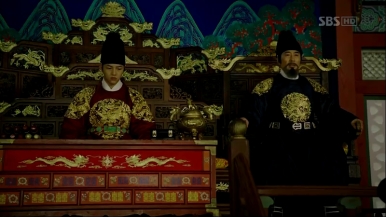
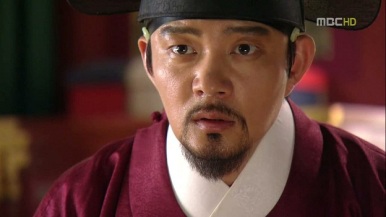
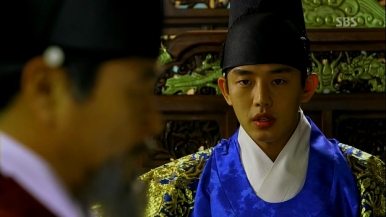
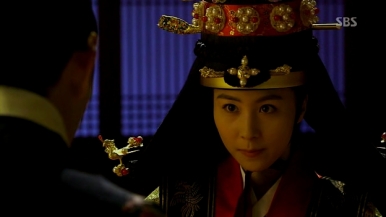

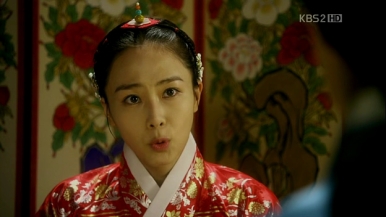
![[JTBC] 인수대비.E49.120519.HDTV.H264-Khai.avi_003110143](https://thetalkingcupboard.files.wordpress.com/2013/04/jtbc-ec9db8ec8898eb8c80ebb984-e49-120519-hdtv-h264-khai-avi_003110143.jpg?w=386&h=216)
In dong yi, btw Jang Ok-jung and Dong yi, whose title is d highest?
Both of them eventually had the highest rank title Bin, but Lady Jang was also the mother of the Crown Prince which made her of higher status compared to Lady Choi. At the time when Lady Jang was alive, Lady Choi had not gotten her Bin title yet so her status was lower compared to Lady Jang.
Annyeong! I have a question about the prince consorts.
Do they live in the palace along with the princess after their marriage, or do they take the princess along with them in their new home?
Thank you for checking on this 🙂
Annyeong~
A princess would follow the prince consort to live outside the palace, but unlike the normal brides who lived together with their in-laws, the princess would live separately in a nice new house, since she’s still a princess, after all 😉
Hiiii I love ur work im a huge fan
I have a question What does the crown prince’s chosen wife wear at their young ages ? And I have seen in don yi the crown prince wears a silver design in his royal attire so then can his future wife wear the same design until they are wed
Hi again!
They would be wearing jeogori and chima in their young days just like other noble women prior to being selected as the Crown Princess. However, she would only be considered a member of the royal family after the official wedding, hence until then, she could only wear silk hanbok just like the other noble women.
I have a question! 😀 If a princess conceived a child without going through legal preparations such as marriage, what will be the social status of the child? Is he/she considered a prince/princess too or whatsoever? Can a boy born out of that situation be eligible for the throne if ever? Thank you! 😀
Hi YiSeul 🙂
I believe that the child would just be another child born out of wedlock and suffer the fate of a illegitimate child, with lower status than normal kid. The child won’t be considered a prince/princess, since the law of Joseon stated that even the legal offspring of a princess was unable to inherit their mother’s royal title. Joseon was a highly patriarchal country and the titles were only passed down through the male line. Hence, this answer the other question: that child won’t be eligible for the throne, not only because he’s born out of wedlock.
Fun fact: Lady Hyegyeong, Crown Prince Sado’s wife and King Jeongjo’s birth mother, was actually the descendant of Princess Jungmyung, King Seonjo’s daughter. However, her father was not considered a royal because of the family status, which followed that of the Hong family, that was a noble at that time. However, Crown Prince Sado’s grandchild through his illegitimate issue was later brought into the court to become the 25th king of Joseon, Cheoljong, despite his illegitimate status. Although he was a distant relative of the royal family, he was still considered a royal.
Wow! Thank you for the info! That was helpful 😁😁😁
Very good job!! I have a question. Were princes (both grand princes and princes) allowed to have concubines? Also, was it considered a scandal if a prince’s legitimate wife didn’t bear any child but one of his concubines did? Thank you!
Hi there 🙂
To answer your questions:
1 – Yes, men were allowed to have concubines, even those of noble births.
2 – Not really a scandal, but in some cases, the child (especially boys) would be adopted and made the official wife’s offspring legally, in order for that child to carry the title of the Prince and continue the family name. Most childless Princesses Consort (if any) might opt for adopting their legitimate nephews to continue the lineage and to preserve the blood in the family.
I have a question! Is Crown princess Consort, Bin Gun higher than concubines of King?
Hello!
By the order of the rank, the Crown Princess would be higher than the King’s concubines, since she was ranked just below the Queen.
Thank you!! That was really helpful to me!!
Pls i dnt really understand something in dong yi Hee Bin, I mean Jang ok Jung is she meant to die?
Why is it that korean hype status, rank much more than anything especially the royal family in North korean and even the rich in South Korea?
Hi..
The real Jang Huibin died because the ministers (on the Noron side) urged for her to be killed because she was suspected of using witchcraft to cause Queen Inhyun’s death.
The fad with status could be caused by the centuries long practice of living in such condition. Korean dynasties were known to exist based on status, so the influence could be seen even in today’s Korea. However, the power has shifted, since the Kims in North and the chaebols in the South were originally from the common class: the Kims were commoners and the chaebols were mostly merchants.
For a Daegun, their sons would be a Gun but what about their daughters? Are they considered a princess too? If a Gun is married, then what is the title for his children? Are there rankings for the princes’ concubines or are they just called a ‘Lady’?
Hi there, Tash!
To answer your questions:
1- The daughter(s) of a Grand Prince, or Daegun, won’t be considered a princess, since the title inheritance was purely for men only, with Joseon being a patriarchal society. She would follow the title and rank of her husband.
2- There are many types of Gun actually (you can refer to this post of mine: https://thetalkingcupboard.com/2015/09/23/royal-ranks-in-joseon-dynasty/) but if you’re referring to the King’s illegitimate son (I’ll refer to the rank as Royal Prince), then it would be like this: his eldest would inherit the title Prince or Gun, while his other legitimate sons would carry the title Jeong. As for his illegitimate issues from his concubines, they would have the title Yeong.
3- There were no exact rankings for the concubines of a Royal Prince, but the treatment they would receive depended on their status; if they were nobles, they would be treated better compared to concubines of humble origin.
Hi! I just wanna ask because I’m pretty confused with the usage of Royal titles before the Joseon Period.
I am currently watching “The Great King’s Dream”. And, I am surprised that Princess Deokman is called as Gongju Cheonha, and sometimes the court will only call her Cheonha. Can anybody explain this because I’ve been used to hearing Cheonha as a title only addressed to Kings. Thank you!
Hi. Do you have any information on what a Queen Consort would call the King? Does she also call him 전하 or 폐하? Also, like how the King calls himself 과인, does the Queen Consort also lower herself when talking to the King? (Other than the usual “저”?) I vaguely recall watching a sageuk movie and the 중전 called herself “소첩” to the King, but is that accurate?
What does the King call her? Is it also just 중전?
Could it be that there’s no kind of…..uhhh “affectionate” formalities to each other at all? Not like the modern 여보 or 자기야 though…
And also, is there any information on what the First Concubine (빈마마) calls the King? Does she also call him 전하/폐하? Is there also a term for herself that she calls herself in front of the King, other than 저?
What does the King call his concubine, and does it depend on their rank too? For now I just want to know the formalities between the King and Bin-mama, like what other terms they call each other if you have any answers…..Thank you!
Hello Amy ^•^ Thanks for the questions!
1- If it’s a King, then the Queen would call him 전하. 폐하 is for an Emperor..
2- The king’s consort (queen/concubine) would address herself as 신첩 in front of the king. 소첩 is used by the consort in front of more senior royalties, like Dowager and the Queen.
3- The King would call the Queen as 중전 and 왕비 in formal setting, but he might call her 부인 or other affectionate terms in private.
4- A 빈 would call the King 전하 because she is clearly lower in rank than him, and she isn’t his official consort. She would addresss herself as 신첩 in front of the King.
5- The King could address his concubine using her rank, title and residence name (if any) in formal setting, especially for record keeping purposes, but in private setting, the King could call the concubine using her first name to be more affectionate.
Hope these answers help! Do drop by if you have questions and I’ll try answering them~
I watched some clips from Queen Seon Deok and I heard them refer to her as 전하 or 폐하. What if 조선 had a 여왕? How should they address her? Just curious.
I think a Queen Regnant in Joseon would still be addressed as 전하, unless the Queen did a turnaround and proclaim the country as an empire, making herself the Empress Regnant to be able to use 폐하.
I see.. what about 마마?
Although 마마 was mostly used for female royalties in Joseon, they were all consorts of the people on the succession line itself. If we are to put Queen Regnant on the same pedestal as a King, then it’s more appropriate to use 전하. Even a Princess in Three Kingdoms Period was addressed as 전하 since her father was the Emperor.
Annyeong 😊
Still remember me?
I’ve ever asked you to send a mail of the name of years during joseon.
I want to know more about the royal titles and styles during Daehan Jeguk. The isnt much information about it.
On Princess Hours, I heard people called Lee Shin “Hwangtaeja jeonha.”
But on The Last Empress, I think I never heard people call Lee Yoon Hwangtaeje jeonha, or maybe I forget 😁
If you find any information about this, please share 😊
Gamsahamnida
Hi! Of course I remember! Hehehe
The list of titles for Korean Empire is quite complicated, since the highest is the Emperor, and the princes could either be the Imperial Crown Prince (Hwangtaeja), the Imperial Prince (Chinwang) or the Prince (Gun).
I think I heard people addressing Lee Yoon as Hwangtaeje, which can be translated as Imperial Crown Brother..but they are usually more senior than him in terms of ranks (like Sunny as the Empress), so the jeonha part will be omitted.
One thing I find interesting in TLE is they are using Ari to bring up the lesser known title of Imperial Crown Princess or Hwangtaenyeo, since the Empire was based on the patriarchal Joseon 😉
How do they address the King when he arrives like in a social hall/gathering? I heard from their eunuch announcing the King like “Kibimama namshoo”. Please excuse my spelling I just trying to expressed here what I’ve heard. Does this mean “The King has arrived.” or “Here comes the King”
Thank you.
Hello!
They usually use “Jusang jeonha napsio~!” which can be roughly translated to “His Majesty the King has arrived!”
Hi, what an amazing blog! Thanks so much for making this post. I have a question, if you have the time to answer. On sageuk shows, I hear the children of the king call their parents “eoma-mama” and “abba-mama” — have I transliterated this correctly? Thank you again, and thanks for this lovely post.
Hello! Glad to know that people still find this post useful 😄
Yes, you heard that right. Eoma mama can be translated to Royal Mother, while Aba mama can be translated to Royal Father. Only the immediate children of the Queen and King can use those to refer to their parents, respectively. As for the children of concubines, the correct term is just the standard eomeonim or Mother. For more info, you can also check out this page: https://thetalkingcupboard.com/resources/sageuk-glossary/ Hope this helps!
If you have things you are curious about, please ask~ I love answering questions and discovering new things along the way 😉
Wow, this blog has been utterly fascinating for someone who is starting to binge on history/period era and its culture. I do have a rather silly question though (have not embarked on many period K-dramas as of yet unfortunately). Does the honorifics in modern day (ie hyung, unnie) also apply amongst those of the same rank? Or is that a modern thing? I’m not sure if I have worded it weirdly… My question should be more of ‘how do princes/princesses address each other in the Joseon era?’ I apologise if an answer has been stated, I combed the Internet but had very little insight… Hopefully you will understand what I mean🙂
Good job on this blog though, will definitely be reading all the articles in the near future.
Cheers!🙂
Thank you so much (ㅠㅇㅠ) I’m so glad something I thought was silly turned out to be helpful and fascinating for others…
There’s no such thing as silly questions, really! Don’t apologize, for I LOVE receiving questions so ask away 😉 I will try my best to feed your curiosity.
For the Princes and Princesses of Joseon, they would probably use the standard hyung-awoo for both genders, at least from what the survived records have shown. King Jungjong used hyung and awoo when referring to each other among his daughters in his letters to them. However, in more casual settings such as in private meetups between close siblings, the Princes and Princesses might use these:
A younger brother to his older sister – nui (누이)/nunim (누님)
A younger brother to his older brother – hyung-nim (형님)
A younger sister to her older sister – hyung-nim/ unni (언니)
A younger sister to her older brother – orabeoni (오라버니)
An older brother to his younger sister – nui dongsaeng (누이 동생)
An older sister to her younger brother – awoo (아우)
An older sister to her younger sister – nui / awoo
An older brother to his younger brother – awoo
A bit complicated, isn’t it? Back then, hyung was used for older siblings of both genders, while there were also males who referred to their older brother as unni. Of course, these were only used between siblings of same mother and father within the same rank. When a Prince/Princess talked with their half-siblings, they would be more formal and refer to each other using titles and styles. It’s the same case with male siblings (be it young or old) when they became Crown Prince or King: formal styles would always be used in formal settings.
I hope this answers your question ^^;; Feel free to ask more if you need more clarification!
Hello,
This is a very informative article thank you!
Out of curiosity do you happen to know where I can find information on the various titles/positions/levels of importance the different children from the concubines had? You mentioned the issue of legitimacy with Prince Gwanghae and I was just wondering what kind of lives and titles the “forgotten” children of the King may have had?
Thank you,
Rachel
Hello Rachel!
Thanks for dropping and leaving a comment 🙂
As for your question, I actually wrote a post here listing the ranks of royal relatives including the princes and princesses of the concubines: https://thetalkingcupboard.com/2015/09/23/royal-ranks-in-joseon-dynasty/ You can also refer to this link in Korean: http://dh.aks.ac.kr/sillokwiki/index.php/%EB%B4%89%EC%9E%91(%E5%B0%81%E7%88%B5)
Prince Gwanghae’s children were all demoted to the status of commoners and they were just referred to as deposed prince/princess in the official documents. His son the deposed Crown Prince passed away in the same year of Gwanghae’s exile while his daughter the deposed princess lived until she was 46. Not much was known about her life after her mother’s death during Gwanghae’s dethronement and Gwanghae’s exile except that she was married, and her death was only mentioned in passing in Veritable Records of King Hyeonjong.
Hey Mimi!
I am curious about the actual meaning of the style “마마”. Is it maybe derived from the chinese language? How is it literally tranlated in english? Also, I’ve noticed that in sageuk, sometimes it is translated as “My Lady” and others as “Your Highness”. Which one of these two titles is the most accurate?
Thank you ❤
Why is 마마 higher than 마마님?
Hi there! I have a question regarding titles. I wanted to know what would the title of the Crown Princess’s parents be? Would be similar to that of the Queen’s? Like the Crown Prince’s father-in-law would be considered as a Buwongun too?
Thank you! Love your blog!
Hi Lily!
There was no exact title reserved for the Crown Princess’s parents (or the Crown Prince’s in-laws) but there would be rapid promotion for the father of the Crown Princess if he was already holding office. The title of Buwongun and Bubuin would only be bestowed once the Crown Princess became the Queen consort. Even if the Crown Princess died prematurely, her parents would still receive the rank and title once she was posthumously honoured as a queen. As for the Queen’s father who passed away before his daughter was made the Queen, he would still be honoured as Buwongun posthumously. Since the rank and title were directly tied to the status of the Crown Princess, the parents would be demoted or not receive any rank should their daughter happened to be deposed and stripped of her title.
Hope this helps ^^
Please who does the title “Buyeong” belong to? I’ve noticed that princes are called “prince Buyeong” for example.
Hello~
Do you mean buwon-gun? If the title is indeed Buyeong-gun, then Buyeong is just a special title when the prince is invested as one. As for buwon-gun, it is a rank title for meritorious subjects in early Joseon and later reserved for the king’s father-in-law, or the queen’s father.